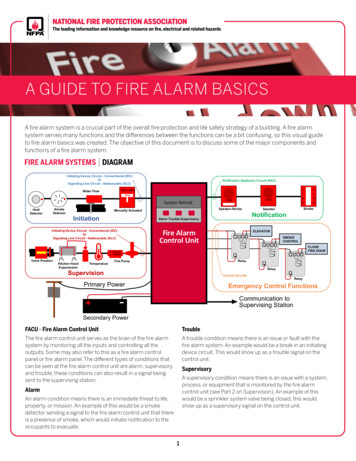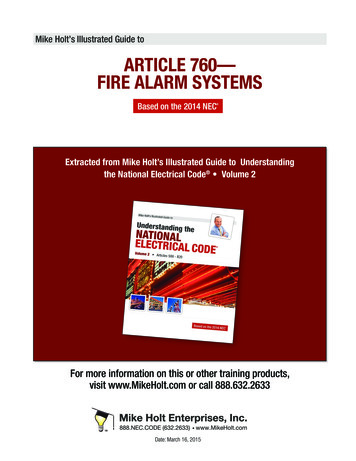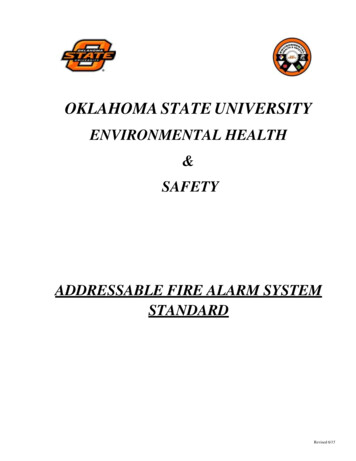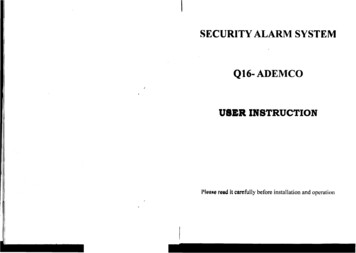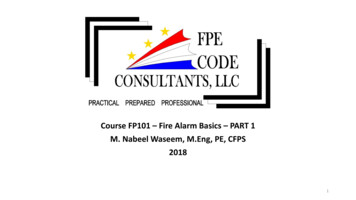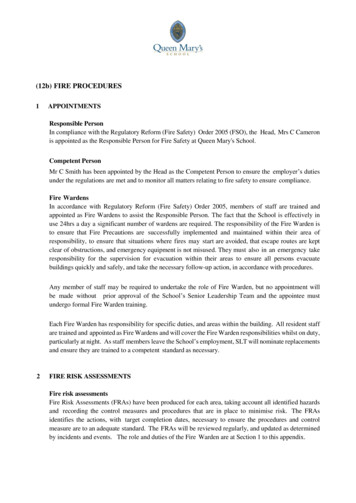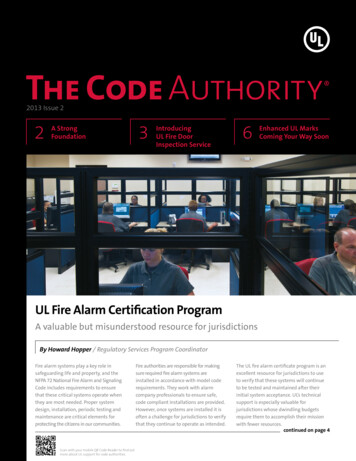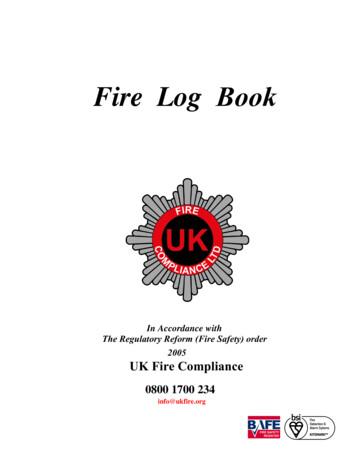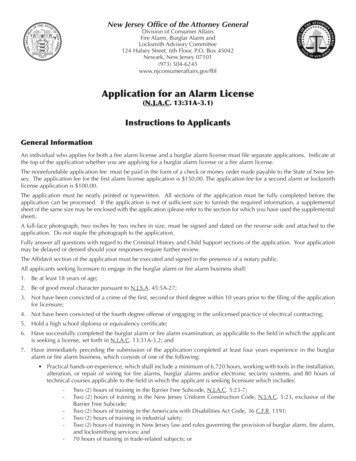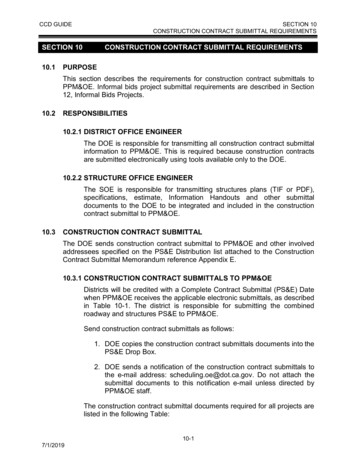
Transcription
Prosper Fire RescueFire Marshal’s OfficePO Box 3071500 E. First StreetProsper, Texas 75078Phone (972) 346-9469 Fax (972) 347-3010 www.prosperfire.comFire Alarm Plan Submittal GuidelinesThese guidelines are provided as an aid to successful prompt plan review and to ensure the minimuminformation required to inform the extent and intent of the work proposed in the town of Prosperbased on the documentation requirements of the adopted national standard NFPA 72. This documentincludes examples of information presented as figures, tables, and best practice recommendations.These examples are not intended to establish the only forms by which this information may bepresented.The following are the codes & standards in force in the Town of ProsperOrdinance/Amendments International Fire Code 2015 International Building Code 2015 International Mechanical Code 2015 The most current published edition of NFPA 72Manufactures Installation InstructionsNational Electrical Code 2017Fall 2018For additional information see our web page at . 10-19 Subject to Change
P age 2Table of Contents3rd Party Plan Review Policies3Plan Review Submittal & Permitting Process – Figure 14Fire Alarm System Design Submittal Check List –Figure 25Drawing Submittal Elements – Figure 36Figure 3a. - Scale Drawing7Figure 3b. - Riser Diagram8Figure 3c. - Circuit Legend9Figure 3d. - Device Legend & Project Materials List10Figure 3e. - Sequence of Operations Matrix11Figure 3f. - Site Map12Figure 3g. - Project Information13Figure 3h. - Design Information14Figure 3i. - Plan Review & Record Drawing Stamp15Fire Alarm Control Unit Battery Calculations Table - Figure 416Voltage Drop Calculations Table - Figure 517Other Resources – Figure 618Fire Alarm System Guidelines Identified in the Prosper Amendments – Figure 719Elevator Recall & Shunt Trip – Figure 820Example Device Wiring & Installation Diagrams21 - 22Example Installation Diagrams22 - 25Supervising Station Communication Methods - Figure 926 - 28Town of Prosper Ordinance/Amendments29 - 30
P age 33rd Party Plan Review PoliciesBureau Veritas shall remain as the exclusive 3rd Party Plan Review firm for all “New and Remodel CommercialConstruction Fire Service” related projects. (All related expenses are the responsibility of the contractor, owner, ordesignated agent).Please contact Bureau Veritas at 817-335-8111 for document handling requirements.System types shall include: Underground fire service Aboveground sprinkler suppression systems Fire Alarm systems Kitchen hood suppression systems Alternative suppression systems Controlled access systems (building and/or gates)The permit shall be issued through the Prosper Fire Marshal’s Office at no charge when the stamped approveddrawings, equipment data package and the approval review letter are received. Bureau Veritas will email ouroffice with the approved submittal package. It is the contractor’s responsibility to assure through Bureau Veritas,we receive all of the documentation in the following manner: Stamped approved drawings in PDF format (as a separate attachment) Equipment data package in PDF format (as a separate attachment) Approval review letter in PDF format (as a separate attachment)System types shall include: Underground fire service Aboveground sprinkler suppression systems Fire Alarm systems Alternative suppression systems Kitchen hood suppression systems Controlled egress doors and controlled access gate systemsContact the Fire Marshal’s Office at 972-346-9469 regarding these requirements. The Fire Marshal’s Office must receive stamped and approved plans, a data submittal package and theapproval review letter in PDF format as three (3) separate attachments before permit issuance.The policies & procedures established under the Prosper Fire Department Ordinance/Amendments fordocumentation collection shall remain unchanged.Please consult the Fire Marshal’s web page at www.prospertx.gov/fire-department/fire-marshal for furtherinformation & instructions.This directive shall remain in effect until further notice.Our goal is to provide a complete and accurate review in the shortest possible time. Our 3rd Party Plan ReviewFirm will strive to accommodate plan review requests within 10 working days for the first submittals, and 5working days for interior finishes (less than 5 initiating and less than 10 notification appliances), including resubmittals.
P age 4Plan Submittal & Permitting ProcessSubmit drawings, equipment datapackage, supporting documentationincluding narrativeTo P.F.D.Approved 3rd Party Plan Review Firm“Approved” drawings, equipmentdata package and approval reviewletter (as 3 separate attachments)Emailed toProsper Fire Marshal’s Officefire.inspections@prosperfire.comApproval rescinded due toreview oversight identifiedby the Fire Marshal’s officeProsper Fire Marshal’s officewill issue the permit at nocharge via emailRe-submit plans toApproved 3rd Party PlanReview FirmWork is allowed to commenceFigure 1
P age 5Submittal Check ListDoes the submittal contain? Electronic scaled drawings in PDF Format Equipment submittal data package in PDF Format Full company information including, street address, city, state & zip, contact name, office number, cellnumber email address, State Registration number (ACR), APS electronic signature in contrasting colorDo the drawings contain? The prescribed Project Information located in the lower-left corner with permit number The prescribed Design Information located in the center bottom System Designer stamp with an electronic signature in contrasting color located in the lower right corner Site map inset showing adjacent street(s) lower right of the scale drawing North arrow and level/floor identification located under the scale drawing Device legend & project bill of materials located to the lower left of the scale drawing General notes to the far left of the scale drawing Riser diagram located to the upper left of the scale drawing Circuit legend located to the upper far left of the scale drawing All walls and doors All partitions extending to within 15 percent of the ceiling height (where applicable and when known) Room and area descriptions System devices/component locations Locations of fire alarm primary power disconnecting means Locations of monitor/control interfaces to other systems System riser locations Type and number of system components/devices on each circuit, on each floor or level Type and quantity of conductors and conduit (if used) for each circuit Identification of any ceiling over 10 ft. (3.0 m) in height where automatic fire detection is being proposed Details of ceiling geometries, including beams and solid joists, where automatic fire detection is beingproposed Where known, the acoustic properties of spaces Device wiring diagramsDoes the Submittal Data Package contain prescribed? Manufacturer’s product information sheets marked with indicating arrows Battery manufacturer data sheet/specifications marked with indicating arrows Wire manufacturer data sheet/specifications marked with indicating arrows Primary power surge suppressor devices marked with indicating arrowsDo the Drawing Notes contain? Jurisdictional authority Designed-in-accordance-with codes, code dates, and local amendments Prescribed initiating circuit wiring description Describe all relevant operation and control functions Describe duct detector operation statementThis checklist is provided as a submittal aid only and is not intended to cover every code requirement.Figure 2
P age 6Shop Drawing (Installation Documentation) ElementsGeneral NotesCircuit LegendRiser DiagramScale DrawingFigure 3cFigure 3bFigure 3aDevice Legend andProject Materials ListSequence of Operation MatrixFigure 3dFigure 3eFloor or LevelIdentificationSite MapGraphic ScaleNorth ArrowFigure 3fFigure 3aPlan Review &Record DrawingStampProject InformationDesign InformationFigure 3gFigure 3hFigure 3Figure 3i
P age 7Scale DrawingFigure 3a
P age 8Riser DiagramFigure 3b
P age 9Circuit LegendFigure 3c
P a g e 10Device Legend & Project Bill of MaterialsFigure 3d
P a g e 11Sequence of Operation MatrixFigure 3e
P a g e 12Site MapFigure 3f
P a g e 13Project InformationProject InformationProject NamePermit NumberDrawing ScaleSheet 1 of 2Street Address, Suite #Construction TypePlot SizeFigure 3gCity, State & ZipSystem Description TitleDrawing Name
P a g e 14Design InformationDesign InformationBuilding/Fire CodeOccupancy ClassificationSystem TypeOther Governing LawsOccupant LoadSprinkler Protection TypeProsper AmendmentsSupervising Station TypeWiring Classification(s)Contractor InformationFull Company NameDesigned ByCompany License NumberStreet Address, Suite #License NumberOffice Phone NumberFigure 3hCity, State & ZipDate DrawnRevision Date(s)
P a g e 15Plan Review & Record Drawings StampFigure 3i
P a g e 16Fire Alarm Control Unit Battery Calculation TableFigure 4
P a g e 17Voltage Drop Calculation TableFigure 5
P a g e 18Other Resources for GuidanceThe following assist to establish clarity with the minimum compliance requirements for the installation andmodification of fire alarm systems as prescribed by national codes & standards, state regulations and as adopted bylocal ordinance. Please Note: Links to this information are under the “Important Website Links” on the FireMarshal’s Website Page @ s Insurance Code Chapter 6002 (formerly Article 5.43-2) Fire Detection and Alarm Device Installationand 28 TAC §§ 34.600 The Fire Alarm Rules - summer 2016 Sec. 6002.003. Effect on Local Regulation §34.607. Adopted Standards §34.611. Licenses and Approvals §34.616. Sales, Installation, and Service (b)(1), (4) §34.617. Certification §34.618. Installation Inspections §34.619. Fire Alarm and Detection System Plans and Record Drawings §34.620. Installation Labels §34.622. Inspection/Test Labels SF-035 – Fire Alarm Installation Certificate SF-229 – Work Permitted by Type of LicenseInternational Fire Code, 2015 Edition nce Chapter 1 – Scope and Administration Chapter 9 – Fire Protection Systems Chapter 80 – Referenced StandardsNFPA 72, Most currently published edition Chapter 1 – Administration Chapter 7 – Documentation Chapter 10 – Fundamentals Chapter 14 – Inspection, Testing & MaintenanceTown of Prosper Ordinances/AmendmentsFigure 6
P a g e 19Fire-Alarm System Guidelines Identified in the Prosper AmendmentsAll alarm systems new or replacement shall be addressable. Alarm systems serving more than 20 smoke detectorsshall be analog addressable.All alarm systems, new or replacement, shall transmit alarm, supervisory and trouble signals descriptively to theapproved supervising station, remote supervisory station or proprietary supervising station as defined in the mostcurrently published edition of NFPA 72, with the correct device designation and location of addressable deviceidentification. Alarms shall not be permitted to be transmitted as a General Alarm or Zone condition.Addressable and analog systems shall contain alarm histories for the past 100 events.All fire alarm systems shall be installed in such a manner that a failure of any single initiating device or single openin an initiating circuit conductor will not interfere with the normal operation of other such devices. All signalingline circuits (SLC) shall be installed in such a way that a single open will not interfere with the operation of anyaddressable devices (Class A). Outgoing and return SLC conductors shall be installed in accordance with currentNFPA 72 requirements for Class A circuits and shall have a minimum of four feet separation horizontal and onefoot vertical between supply and return circuit conductors. The initiating device circuit (IDC) from an addressableinput (monitor) module may be wired Class B, provided the distance from the addressable module to the initiatingdevice is ten feet or less.Where the fire alarm control panel is not visible from the front (main) entry, a remote annunciator shall be locatedat the entry and in the sprinkler riser room. A sign shall be provided to identify the Main Panel location.All fire alarm wire jacketing shall be Red in color, however utilizing color striping for circuit designation isacceptable as long as the base jacket is Red in color.Systems shall be restorable without the use of a code or any special knowledge. This can be accomplished throughthe use of buttons or switches located at the remote annunciator or main control panel.The main power shall be from a dedicated circuit. The location of the branch circuit disconnecting means shall bepermanently identified at the control unit and at the power source. For fire alarm and/or signaling systems, the circuitdisconnecting means shall have a red marking. Where a circuit breaker is the disconnecting means, an approvedbreaker locking device shall be installed. An overcurrent protective device shall be provided in accordance withNFPA 70.Secondary power source utilizing batteries shall be marked with a label of contrasting colors (white backgroundwith black numbers/letters). The label shall indicate the month and year of manufacture using the month/year format.Where the battery is not marked with the month/year by the manufacturer, the installer shall obtain the date-codeand mark the battery with the month/year of battery manufacture.Battery and voltage-drop calculations, in formats similar to those provided in Figure 5, page 17 and Figure 6, page18, that include all input values for verification. Where summary or average values are input, the derivation of thesevalues must be provided.All manual fire-alarm pull-boxes shall be of the double-action type and Red in color.Occupant notification in accordance with this section and 907.5 shall be required for all new construction, or existingconstruction complying with the International Building Code, for renovations to existing buildings, tenant spaces,changes in occupancy, replacement or modification of the existing fire alarm system, or as required by the fire codeofficial, for all buildings or spaces provided with an approved automatic sprinkler system.When required by Section 903.4.2, an exterior audible and visible notification appliance shall be provided on theexterior of the building and shall be located above the remote Fire Department Connection. The notificationappliance shall operate on a water flow alarm only, shall be non-silenceable and shall continue to operate after thepanel is silenced on the condition the alarm was a water flow alarm only.The notification appliance shall be wired from the fire alarm control panel as a dedicated latching circuit. The alarmappliance required on the exterior of the building shall be a weatherproof horn/strobe with a minimum 75-candelastrobe rating, installed as close as practicable to the fire department connection. When the project has a remote firedepartment connection a 2nd weatherproof horn/strobe with a minimum 75-candela strobe rating shall be mountednot less than (7’) seven feet above finished grade above the FDC connection.Figure 7
P a g e 20Elevator Recall and Shunt TripState and local codes regulate elevator installations. Codes that affect fire safety are summarized in this section.Elevator recall Elevator recall shall be from a smoke detector activation in the elevator lobby or machine room Detectors in the elevator lobby and machine rooms shall be smoke type in conditioned spaces and heatdetectors in unconditioned spaces. Elevator machine rooms without fire sprinklers shall contain smoke detector(s) for recall only. Where therooms are unconditioned, heat detectors shall be provided (135 to 165 )Fire sprinklers shall not be installed in the top of elevator shafts or in the elevator machine rooms.Exception:NFPA 13 – 9.3.6.1* Sidewall spray sprinklers shall be installed at the bottom of each elevator hoistway not morethan 2 ft. (600 mm) above the floor of the pit.NFPA 13 – 9.3.6.2. The sprinkler required at the bottom of the elevator hoistway by 9.3.6.1 shall not berequired for enclosed, noncombustible elevator shafts that do not contain combustible hydraulic fluids.NFPA 72 - 21.3.8* When sprinklers are required in elevator hoist-ways by other codes and standards, fire alarminitiating devices shall be installed to initiate Elevator Phase I Emergency Recall Operation in accordance withANSI/ASME A17.1/CSA B44, Safety Code for Elevators andEscalators, and the following shall apply:(1) Where sprinklers are located at the top of the hoistway, the fire detection device(s) shall be located atthe top of the hoistway.(2) Where sprinklers are located at the bottom of the hoistway (the pit), fire detection device(s) shall beinstalled in the pit in accordance with Chapter 17.(3) Outputs from the fire alarm system to the elevator system shall comply with 21.3.14.(4) The fire alarm initiating device(s) shall be installed in accordance with Chapter 17.TDLR §74.100. Technical Requirements--ASME and ASCE Codes.(a) The commission adopts the standards for the installation, maintenance, repair, replacement, alteration,testing, operation, and inspection of equipment that are contained in the following codes:(1) ASME Code A17.1-2007/CSA B44-07 as amended in subsection (b)(2) ASME Code A17.3-2002(3) ASME Code A18.1-2005; and(4) ASCE Code 21.Chapter 74, Elevators, Escalators and Related EquipmentPage 17-RFebruary 15, 2016Elevator shunt trip: Passenger elevator shafts and elevator machine rooms are exempt from power shunting when sprinklersuppression is not present. Freight elevator systems and hydraulically operated passenger systems maynot be exempt from this requirement. Please consult ASME Code A17.1-2007/CSA B44-07 Safety Codefor Elevators and Escalators, NFPA 13 and NFPA 72 for further clarity.Elevator cars shall be provided with a 2-way communication system. The communication system must beconnected to either a constantly attended (24 hour) location or to a UL-approved monitoring station.Figure 8
P a g e 21Example Device Wiring & Installation DiagramsNFPA 72 - 7.4.8 Typical wiring diagrams shall be provided for all initiating devices, notification appliances,remote indicators, annunciators, remote test stations, and end-of-line and power supervisory devices.
P a g e 22Example Device Wiring & Installation Diagrams continuedNFPA 72 - 7.4.8 Typical wiring diagrams shall be provided for all initiating devices, notification appliances,remote indicators, annunciators, remote test stations, and end-of-line and power supervisory devicesExample Installation Diagrams
P a g e 23Example Installation Diagrams continued
P a g e 24Example Installation Diagrams continued
P a g e 25Example Installation Diagrams continued
P a g e 26NFPA Supervising Station Communication MethodsThe Town of Prosper recognizes the rapidly retreating support of traditional analog copper-based telephonecommunications methods in favor of newer transmission technologies with their attendant advances incommunication capability. In consideration of the impact these advances must have on supervising station firealarm system communication capabilities now and into the future, the Town of Prosper embraces and promotesthe use of listed equipment using alternate communication methods described in chapter 26 of NFPA72 20132016 editions.All methods of communications between the protected premises and a Listed/Approved Supervising Station areaccepted in the Town of Prosper as long as they comply with: Federal Communications Commission Rules & Regulations as applicableThe manufacturers' product as Listed and/or F.M. Approved for such Services If providing a “Performance-Based Design”, it must comply with all of the above, reviewed and approvedby a Registered Fire Protection Engineer and Acceptable to the A.H.J. Compatibility between the manufactured product and the supervising stationIf you require further clarification please consult and provide this document to your registered Alarm PlanningSuperintendent (APS), registered Fire Protection Engineer (FPE), manufacturers’ product or the third partysupervising station representative.FCC RulingFCC ruling 14-5A1 dated 01-30-2014 established regulations that will accommodate the nation’s telephoneservice providers to begin the phasing out of hard wire (copper) telephone lines (POTS) and Publically SwitchedTelephone Networks. Accordingly; the current edition of NFPA 72 recognizes this action and has establishedrestrictive methods of communications utilizing a Digital Alarm Communications System (DACT). Pleasereference NFPA 72, Chapter 26, section 26.6.3.2 Digital Alarm Communicator Systems for clarity.Further Clarification Excerpts from NFPA 72, 2019 Edition HandbookNational Fire Alarm and Signaling Code Handbook, 2019 Edition26.6 Communications Methods for Supervising Station Alarm Systems.Three classifications of communications methods are addressed in the Code. The transmitters for these methodsare situated at the protected premises. The first classification includes performance-based technologies, which arecovered in 26.6.3. This classification includes technologies that at one time were called “other technologies.”These technologies include equipment such as IP communicators and global system for mobile (GSM)communications. Legacy technologies are also included under the performance-based grouping. For the most part,legacy technologies are no longer being installed but may exist in some installations. Finally, performance-basedtechnologies can include any newly developed communications method that can meet the requirements of 26.6.3.The second communications classification includes the digital alarm communicator system (DACS), addressed in26.6.4. These systems use a DACT at the protected premises and a DACR at the supervising station.The third communications classification includes radio systems, which are covered in 26.6.5. This classification issplit into two types of radios. Paragraph 26.6.5.1 provides the requirements for two-way radio frequency (RF)multiplex systems. Paragraph 26.6.5.2 provides the requirements for one-way private radio alarm systems, whichare more common. These communications methods are addressed in more detail in the subsequent commentary.Exhibit 26.9 illustrates the communications methods addressed by the Code.
P a g e 2726.6.1* Application.26.6.4.1.4 Transmission Channels.(A) A system employing a DACT shall employ a single telephone line (number) and one of the followingtransmission means shall be employed:(1) One-way private radio alarm system(2) Two-way RF multiplex system(3) Transmission means complying with 26.6.3(4) A second telephone line (number), where all of the following are met:(a) Access to one of the technologies in (1), (2), or (3) is not available at the protected premises.(b) The authority having jurisdiction approves the arrangement. (c) The DACT is programmed tocall a second DACR line (number) when the signal transmission sequence to the first called line(number) is unsuccessful. (d) The DACT is capable of selecting the operable means oftransmission in the event of failure of the other means.(e) Each telephone line is tested in accordance with 26.6.4.1.4(B) or at alternating 6-hourintervals.NFPA Supervising Station Communication Methods continuedNFPA 72 - CommentaryParagraph 26.6.4.1.4 provides the DACT with two reasonably reliable means of connecting to the DACR. Notethat the Code has no jurisdiction over utility-provided services such as telephone services. Thus, the Code mustrely on the traditionally accepted inherent reliability of all such utility-provided services. See also thecommentary and the Closer Look feature following A.26.6.4.1.1.Due to the decreased reliability of both traditional and MFVN-based PSTNs, this does not permit the use of asecond telephone line (number) as the second transmission means for a DACT. Several of the other transmissionchoices are not included either because they are no longer available or were never used, such as derived localchannel, integrated services digital network (ISDN), and private microwave radio. The traditional cell phoneservice that had to dial a number is also not permitted. However, digital cellular radio using ubiquitous 2G, 3G,4G, and 5G wireless networks is capable of meeting the performance-based requirements of 26.6.3.The distinction between a DACS that meets the requirements of 26.6.4 and a system using performance-basedtechnology that meets the requirements of 26.6.3 is particularly important for designers and authorities havingjurisdiction to understand. In many cases, this second system employs a listed DACT connecting to a listedmodule (sometimes called an IP communicator) that transmits as a packet-switched network through an IPbroadband data connection to the Internet. See the commentary following Section 26.6. Both systems mustcomply with the distinct requirements of the applicable section of the Code. The requirements of 26.6.4 do notneed to be applied to systems addressed under the requirements of 26.6.3 even though they may employ a listedmodule interfacing with a listed DACT. The equipment manufacturer’s published instructions are required to befollowed in these situations, in addition to the requirements of 26.6.3.It is estimated that the migration to performance-based technologies will continue until the vast majority ofDACTs use IP broadband data communications technology or a yet-to-be-developed equivalent.
P a g e 28Figure 9
P a g e 29Town of Prosper, Texas Ordinance/AmendmentsFire Alarm Only(Visit www.prospertx.gov/fire-department/fire-marshal/ for a complete copy of our amendments)Section 907.1.4 shall be added to read as follows:907.1.4. Design Standards. All alarm systems new or replacement shall be addressable. Alarm systems serving morethan 20 smoke detectors shall be digital and/or analog addressable.Riser rooms shall be equipped with an annunciator panel.Exception: Existing systems need not comply unless the total building remodel or expansion initiated after theeffective date of this code, as adopted, exceeds 30% of the building. When cumulative building remodels orexpansion exceeds 50% of the building, must comply within 18 months of permit application.Section 907.2.1 shall be amended to read as follows:907.2.1 Group A. A manual fire alarm system that activates the occupant notification system in accordance withSection 907.6 shall be installed in Group “A” occupancies having an occupant load of 300 or more persons ormore than 100 persons above or below the lowest level of exit discharge. Portions of Group E occupanciesoccupied for assembly purposes shall be provided with a fire alarm system as required for the Group E occupancy.Activation of fire alarm notification appliances shall:1. Cause illumination of the means of egress with light of not less than 1 foot-candle (11 lux) at the walkingsurface level, and2. Stop any conflicting or confusing sounds and visual distractions.Section 907.2.3 shall be amended to read as follows:907.2.3 Group E. A manual fire alarm system that activates the occupant notification system in accordance withSection 907.6 shall be installed in Group E educational occupancies. When automatic sprinkler systems or smokedetectors are installed, such systems or detectors shall be connected to the building fire alarm system. Anapproved smoke detection system shall be installed in Group E day care occupancies. Unless separated by aminimum of one hundred feet (100') of open space, all buildings, whether portable buildings or the main building,will be considered one building for alarm occupant load consideration and interconnection of alarm systems.Section 907.2.3 shall be amended to amend Exception 1 and to addException 1.1 to read as follows:Exceptions:1. A manual fire alarm system is not required in Group E educational and daycare occupancies with anoccupant load of less than 50 when provided with an approved automatic sprinkler system.1.1. Residential In-Home daycare with not more than (12) children may use interconnected single stationdetectors in all habitable rooms. For care of more than five children 2 ½ or fewer years of age, see Section907.2.6.)Section 907.2.13, Exception 3 shall be amended to read as follows:Open-air portions of buildings with an occupancy in Group A-5 in accordance with Section 303.1 of theInternational Building Code; however, this exception does not apply to accessory uses including but not limited toskyboxes, restaurants and similarly enclosed areas.Section 907.4.2.7 shall be added to read as follows:Section 907.4.2.7 Type. Manual alarm initiating devices shall be an approved Red, double-action type.
P a g e 30Town of Prosper, Texas Ordinance/Amendments continuedFire Alarm OnlySection 907.5.3 shall be added to read as follows:Occupant notification in accordance with this section and 907.5 shall be required for all new construction, orexisting construction complying with the International Building Code, for renovations to existing buildings, tenantspaces, changes in occupancy, replacement or modification of the existing fire alarm system, or as required by thefire code official, for all buildings or spaces provided with an approved automatic sprinkler system.Section 907.6.1.1 shall be added to read as follows:907.6.1.1 Wiring Installation. (Class A). Outgoing and return SLC conductors shall be installed in accordance withNFPA 72 requirements for Class A circuits and shall have a minimum of four feet separation horizontal and one footvertical between supply and return circuit conductors. The initiating device circuit (IDC) from an addressable input(monitor) module may be wi
Alternative suppression systems Kitchen hood suppression systems Controlled egress doors and controlled access gate systems Contact the Fire Marshal's Office at 972-346-9469 regarding these requirements. The Fire Marshal's Office must receive stamped and approved plans, a data submittal package and the
